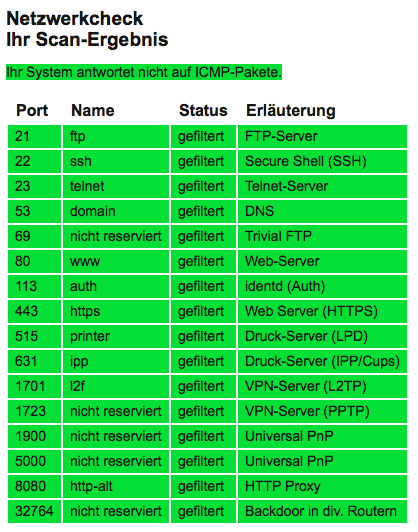Portscan
Check your router!
I was pretty surprised to read in this article, that a number of brand-name routers offer a “backdoor” via their WAN IP, Port 32764. Via this port, it is possible to read out various variables and settings, the knowledge of which greatly aid a hacker trying to get into the private network behind the device.
In some cases, it was apparently possible to change settings in the router via this port!!!
So: you may do well to make sure your router isn’t affected. Heise Verlag of Germany offers a free scan service that - using your IP address (which your Webbrowser knows about) - scans your router from the outside to see if it can find any open ports (that shouldn’t be).
For all you non-German-speakers out there, just click the “Ich bestätige, dass ich berechtigt bin, die IP-Adresse x.x.x.x zu scannen.” Checkbox (which indicates that you’re permitting the port scan to happen, and that you have the right to have that address scanned) and select the “Router-Backdoor” radio button. Then hit “Scan starten” and you get a result nearly instantly.
You may also wish to run the “Router” version of the test, which checks more ports as well as the just discussed “backdoor” port:

If the result is green, you’re good to go - if it is red, well then you have a problem.
If you’re versed in IP ports, you may also want to do the check with either the “Windows standard” or “UNIX standard” radio buttons selected - these do extensive port scans based on wether you’re using a Windows or a UNIX-based (MacOS, Linux, etc.) computer.
In some cases, it was apparently possible to change settings in the router via this port!!!
So: you may do well to make sure your router isn’t affected. Heise Verlag of Germany offers a free scan service that - using your IP address (which your Webbrowser knows about) - scans your router from the outside to see if it can find any open ports (that shouldn’t be).
For all you non-German-speakers out there, just click the “Ich bestätige, dass ich berechtigt bin, die IP-Adresse x.x.x.x zu scannen.” Checkbox (which indicates that you’re permitting the port scan to happen, and that you have the right to have that address scanned) and select the “Router-Backdoor” radio button. Then hit “Scan starten” and you get a result nearly instantly.
You may also wish to run the “Router” version of the test, which checks more ports as well as the just discussed “backdoor” port:

If the result is green, you’re good to go - if it is red, well then you have a problem.
If you’re versed in IP ports, you may also want to do the check with either the “Windows standard” or “UNIX standard” radio buttons selected - these do extensive port scans based on wether you’re using a Windows or a UNIX-based (MacOS, Linux, etc.) computer.
Comments